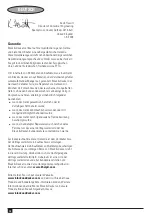
5
Electrical safety
This tool is double insulated; therefore no earth wire
is required. Always check that the power supply
corresponds to the voltage on the rating plate.
Additional safety instructions for sanders
◆
Always wear a dust mask whenever sanding.
◆
Thoroughly remove all dust after sanding.
◆
Take special care when sanding paint which is possibly
lead based or when sanding some woods and metal
which may produce toxic dust:
- Wear a dust mask specifically designed for protection
against lead paint dust and fumes and ensure that persons
within or entering the work area are also protected.
- Do not let children or pregnant women enter the work
area.
- Do not eat, drink or smoke in the work area.
- Dispose of dust particles and any other debris safely.
Features
1. On/off switch
2. Gel comfort grip
3. Dust extraction outlet
4. Dust bag
5. Sanding base
6. Paper clamp lever
7. Paper punch
Assembly
Warning!
Make sure that the tool is switched off and
unplugged.
Fitting sanding sheets (fig. A - C)
Warning!
Never use the tool without a sanding sheet or
accessory in place.
Fitting sanding sheets with nylon loops (fig. A)
◆
Make sure that the tool is switched off and unplugged.
◆
Press the sheet firmly and evenly onto the sanding base
(5), making sure that the holes in the sheet line up with
the holes in the base.
Fitting regular sanding sheets (fig. B)
◆
Make sure that the tool is switched off and unplugged.
◆
Soften the sanding sheet by rubbing its non-abrasive side
over the edge of a worktop.
◆
Press the paper clamp levers (6) upwards to release them
from the retaining grooves and open the paper clamps by
pressing them down.
◆
Place the sheet onto the sanding base.
◆
Insert the edge of the sanding sheet into the front paper
clamp as shown.
ENGLISH
◆
Press the front paper clamp lever (6) downwards and
locate it in the retaining groove.
◆
While keeping a slight tension on the sheet, insert the
rear edge of the sheet into the rear paper clamp.
◆
Press the rear paper clamp lever (6) downwards and
locate it in the retaining groove.
Punching sanding sheets (fig. C)
The paper punch (7) is used for punching dust extraction holes
in sanding sheets without pre-punched holes. For optimum
convenience the paper punch can be fitted to a workbench
using the screw holes (8).
◆
Fit a sanding sheet.
◆
Hold the tool in position right above the paper punch (7).
◆
Press the tool with the sanding base (5) down into the
paper punch.
◆
Take the tool off the paper punch and check whether the
holes in the sanding sheet have been fully pierced.
Fitting and removing the dustbag (fig. D)
◆
Fit the dustbag (4) over the dust extraction outlet (3).
◆
To remove the dustbag, pull the dustbag to the rear and
off the outlet.
Louvre attachment (fig. E)
With this attachment you can work in crevices and use the
sanding base on both sides.
◆
Remove the screws holding the sanding base to the tool.
◆
Fit the louvre base (9) over the sanding base.
◆
Secure the louvre base using the long screws (10).
◆
Stick a 1/2 sheet to the underside of the louvre base.
Part of it will stick to the front part of the base.
Use
Switching on and off
◆
To switch the tool on, press the
I
part of the on/off switch
(1).
◆
To switch the tool off, press the
O
part of the on/off switch.
Emptying the dustbag
The dustbag should be emptied every 10 minutes.
◆
Shake the dustbag to empty the contents.
Hints for optimum use (fig. F)
◆
Hold the tool as shown.
◆
Do not exert too much pressure on the tool.
◆
Regularly check the condition of the sanding sheet.
Replace when necessary.
◆
Always sand with the grain of the wood.
◆
When sanding new layers of paint before applying
another layer, use extra fine grit.
Содержание KA170GT
Страница 2: ...2 3 4 6 5 6 D C B A 7 5 8 ...
Страница 3: ...3 E 10 9 F ...
Страница 48: ...48 ...
Страница 49: ...49 ...






































